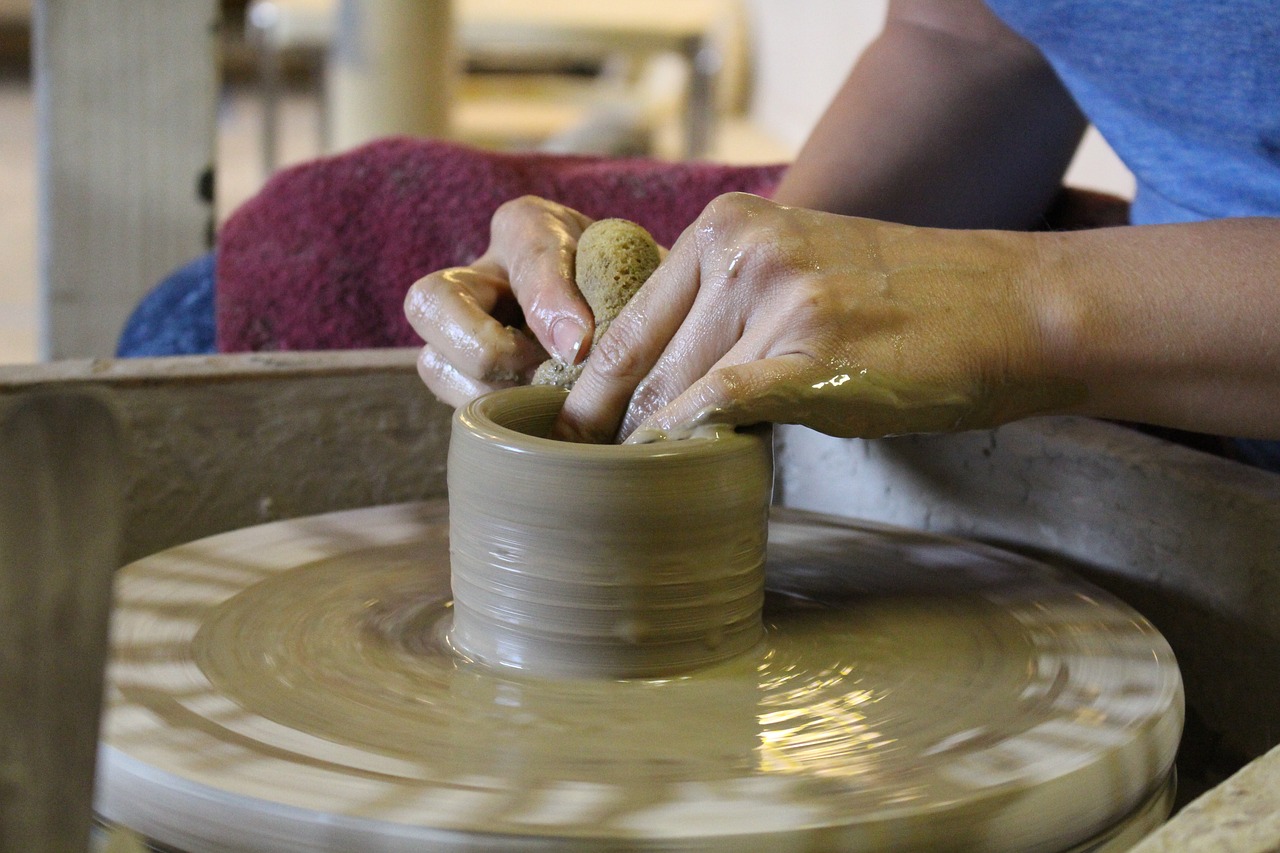The Significance of Ancient Greek Pottery
Ancient Greek pottery holds a profound significance in the realms of history, culture, and art, offering a window into the past that captivates both scholars and enthusiasts alike. These vessels, crafted with meticulous detail and artistic flair, not only served practical purposes but also carried symbolic meanings that reflected the beliefs and values of ancient Greek society.
From the Geometric period to the Classical era, Greek pottery underwent a remarkable evolution, showcasing a diverse range of styles, techniques, and functions. Each piece tells a unique story, shedding light on the daily lives, religious practices, and diplomatic exchanges of the people who created and used them.
The intricate designs and motifs adorning Greek pottery speak volumes about the craftsmanship and creativity of ancient artisans. Techniques like black-figure and red-figure painting brought scenes of mythology, warfare, and daily activities to life, showcasing the mastery of these skilled potters.
Not merely confined to domestic use, Greek pottery played a crucial role in international trade networks, acting as cultural ambassadors that spread Greek influence far and wide. These vessels traveled across the Mediterranean, carrying with them tales of a civilization renowned for its artistry and innovation.
Today, the archaeological significance of Greek pottery cannot be overstated. Excavations have unearthed a treasure trove of these ancient artifacts, offering invaluable insights into the social structures, economic activities, and artistic preferences of the ancient Greeks.
The enduring legacy of Ancient Greek pottery extends beyond the confines of history books, influencing modern art movements and inspiring contemporary artists to reinterpret and reimagine classical themes. The echoes of the past resonate in the works of those who continue to draw inspiration from these timeless masterpieces.
However, the preservation and conservation of ancient Greek pottery present a myriad of challenges. Issues surrounding restoration, display, and ethical considerations require careful deliberation to ensure that these cultural treasures are safeguarded for future generations to appreciate and study.
Delving into the world of collecting and studying Greek pottery reveals a community of dedicated individuals, from scholars to museum curators to passionate collectors, who are committed to unraveling the mysteries and complexities of these ancient vessels. Their efforts contribute to the ongoing dialogue surrounding the significance and enduring allure of Ancient Greek pottery.

History of Greek Pottery
Exploring the historical, cultural, and artistic importance of Ancient Greek pottery, shedding light on its role in society, trade, religious practices, and its influence on modern art and archaeology.
Understanding the evolution of Greek pottery from the Geometric period to the Classical era is like uncovering a time capsule that reveals the artistic prowess of ancient civilizations. The journey through history showcases a remarkable transformation in styles, techniques, and purposes behind the creation of these vessels. From the simple geometric patterns of the early periods to the intricate designs and narrative scenes depicted in later eras, Greek pottery tells a tale of innovation and cultural expression.

Symbolism and Functionality
Ancient Greek pottery holds a deep significance in the realms of historical, cultural, and artistic domains. These vessels were not merely utilitarian objects but served as powerful symbols and functional tools in various aspects of Greek society. Let's delve into the intricate world of Greek pottery to uncover the layers of symbolism and functionality embedded within these ancient artifacts.
Symbolism played a crucial role in the creation and use of Greek pottery. These vessels were adorned with intricate designs and motifs that carried symbolic meanings related to mythology, religion, and social customs. For example, the depiction of gods and heroes on pottery not only showcased artistic prowess but also conveyed narratives of the divine and heroic realms. Additionally, the use of specific colors and patterns on pottery could signify wealth, status, or even political affiliations, making these vessels essential elements in social and ceremonial contexts.
Functionality was another key aspect of Greek pottery, serving a multitude of purposes in daily life and rituals. From storing food and liquids to being used in religious ceremonies and funerary practices, these vessels were versatile tools that permeated various aspects of Greek culture. Moreover, Greek pottery often served as diplomatic gifts, exchanged between city-states or given as offerings to foreign dignitaries, highlighting their role in fostering diplomatic relations and showcasing artistic excellence.
The marriage of symbolism and functionality in Greek pottery created a rich tapestry of cultural expressions, where each vessel told a story of its own. Whether used in banquets, religious rites, or as grave goods, these artifacts reflected the values, beliefs, and aesthetics of ancient Greek civilization, providing modern scholars with invaluable insights into the past.

Techniques and Designs
Exploring the historical, cultural, and artistic importance of Ancient Greek pottery, shedding light on its role in society, trade, religious practices, and its influence on modern art and archaeology.
Understanding the evolution of Greek pottery from the Geometric period to the Classical era, examining the different styles, techniques, and purposes behind the creation of these vessels.
Exploring the symbolic meanings and functional aspects of Greek pottery, including its use in daily life, religious ceremonies, funerary practices, and as diplomatic gifts.
Investigating the intricate pottery-making techniques employed by ancient Greek artisans, such as black-figure and red-figure painting, and analyzing the diverse designs and motifs used in their creations.
Ancient Greek pottery was not merely utilitarian but a canvas for artistic expression. The techniques used by Greek artisans were revolutionary for their time, with black-figure and red-figure painting being prominent methods. Black-figure painting involved the use of black slip to create figures and decorations on a red clay background, while red-figure painting reversed this technique, allowing for more intricate details and realism. The intricate designs and motifs depicted on these vessels ranged from mythological scenes to everyday life, showcasing the skill and creativity of the artists.
Examining the role of Greek pottery in international trade networks, exploring how these vessels were exported across the Mediterranean and beyond, contributing to the spread of Greek culture.
Highlighting the importance of Greek pottery in archaeological studies, discussing how these artifacts provide valuable insights into ancient Greek society, economy, and artistic practices.
Tracing the influence of Ancient Greek pottery on modern art movements, such as the neoclassical revival, and exploring how contemporary artists continue to draw inspiration from these ancient masterpieces.
Discussing the challenges of preserving and conserving ancient Greek pottery, addressing issues related to restoration, display, and the ethical considerations surrounding the trade of these cultural artifacts.
Exploring the world of collecting and studying Greek pottery, highlighting the work of scholars, museums, and enthusiasts dedicated to unraveling the mysteries of these ancient vessels.

Trade and Commerce
When delving into the realm of Ancient Greek pottery, one cannot overlook the pivotal role it played in trade and commerce during antiquity. These exquisite vessels were not only cherished for their artistic value but also served as valuable commodities that were traded far and wide, shaping the interconnected web of international trade networks that spanned the Mediterranean and beyond.
Ancient Greek pottery, renowned for its quality and craftsmanship, found its way into the hands of merchants and traders who recognized its allure and marketability. The demand for Greek pottery transcended borders, with these vessels becoming sought-after items in regions far from their place of origin.
One of the key factors that contributed to the widespread distribution of Greek pottery was its durability and practicality. These vessels were not only decorative pieces but also functional containers used for various purposes, from storing goods to serving food and drink. Their versatility made them highly desirable commodities in the bustling markets of the ancient world.
The trade of Greek pottery was not merely a commercial transaction but also a cultural exchange. As these vessels made their way to distant lands, they carried with them the artistic and cultural heritage of ancient Greece, influencing local artistic traditions and aesthetic sensibilities.
Through the trade of Greek pottery, a dialogue of artistic expression and cultural exchange was fostered, enriching the tapestry of civilizations that came into contact with these remarkable artifacts. The legacy of Greek pottery as a symbol of trade and commerce endures to this day, serving as a testament to the enduring impact of ancient Greek civilization on the world stage.

Archaeological Significance
Delving into the of Ancient Greek pottery unveils a treasure trove of historical insights and cultural revelations. These artifacts serve as invaluable windows into the past, offering archaeologists and historians a glimpse into the daily lives, beliefs, and artistic prowess of the ancient Greeks. Through the meticulous study of Greek pottery fragments found in archaeological sites, researchers can piece together the puzzle of ancient Greek society, shedding light on aspects of economy, trade, religious practices, and social customs.
One of the most remarkable aspects of Greek pottery is its ability to transcend time and communicate across centuries. The intricate designs, motifs, and inscriptions adorning these vessels provide clues about the craftsmen who created them, the regions where they were produced, and the cultural exchanges that took place through trade and commerce. By analyzing the shapes, colors, and styles of Greek pottery, archaeologists can trace the evolution of artistic techniques and aesthetic preferences throughout different periods of ancient Greek history.
Moreover, the discovery of Greek pottery in tombs, sanctuaries, and residential areas has provided researchers with valuable evidence of ancient burial practices, religious rituals, and domestic life. The presence of specific types of pottery in funerary contexts suggests beliefs in the afterlife and the importance of honoring the deceased with grave goods. Similarly, the use of painted pottery in religious ceremonies underscores the spiritual significance attributed to these vessels, linking them to the divine and the sacred.
Through the meticulous documentation and analysis of Greek pottery fragments, archaeologists can reconstruct ancient workshops, kilns, and production centers, offering insights into the technological advancements and innovations of the time. By studying the distribution patterns of Greek pottery across different regions, scholars can map out trade routes, economic networks, and cultural interactions, illuminating the interconnectedness of the ancient Mediterranean world.
In conclusion, the Archaeological Significance of Ancient Greek pottery transcends mere aesthetic appeal, serving as a rich tapestry of historical narratives, cultural practices, and artistic achievements. These humble vessels, once used for everyday purposes, now stand as enduring testaments to the ingenuity and creativity of the ancient Greeks, inviting us to embark on a fascinating journey through time and space.

Influence on Modern Art
When we delve into the realm of modern art, it becomes evident that Ancient Greek pottery holds a significant influence that transcends time. The elegant forms, intricate designs, and symbolic motifs found on these ancient vessels have inspired countless artists throughout history. From the neoclassical revival of the 18th century to contemporary art movements, the legacy of Greek pottery continues to shape the artistic landscape.
Imagine a sculptor, captivated by the graceful curves of a Greek amphora, incorporating elements of its design into a contemporary sculpture. Picture a painter, drawing inspiration from the intricate black-figure painting techniques of ancient artisans, infusing their own work with a sense of history and tradition. The influence of Ancient Greek pottery is not limited to mere imitation but serves as a wellspring of creativity, sparking new ideas and pushing boundaries in the world of art.
One cannot overlook the role of Greek pottery in the development of art history as a whole. The discovery and study of these ancient artifacts have provided art scholars with invaluable insights into the techniques, aesthetics, and cultural significance of ancient Greek art. By examining the subtle details of a finely crafted kylix or the narrative scenes depicted on a krater, artists and art enthusiasts alike gain a deeper appreciation for the mastery of the ancient craftsmen.

Preservation and Conservation
Preservation and conservation of ancient Greek pottery pose significant challenges in the field of archaeology and cultural heritage. The delicate nature of these artifacts, often fragmented and weathered by time, requires meticulous care and expertise to ensure their longevity for future generations to appreciate and study. Conservation efforts involve a combination of scientific analysis, restoration techniques, and ethical considerations to balance the preservation of the original material with the need for public display and research.
One of the primary concerns in the preservation of Greek pottery is the restoration of broken pieces to reconstruct the vessel while maintaining its authenticity. Conservators employ various methods, including adhesive bonding, gap filling, and surface cleaning, to stabilize and protect the pottery from further damage. Additionally, the storage and display of these artifacts require controlled environmental conditions to prevent deterioration caused by light exposure, humidity, and temperature fluctuations.
Conservation laboratories play a crucial role in assessing the condition of ancient Greek pottery and developing tailored treatment plans to address specific issues such as surface flaking, mineral deposits, or previous restoration attempts. Scientific analysis, such as X-ray fluorescence and microscopy, helps conservators identify the materials used in the creation of the pottery and understand its degradation mechanisms, guiding conservation decisions.
Furthermore, ethical considerations surrounding the trade and ownership of ancient artifacts raise questions about the responsible acquisition and display of Greek pottery. Museums and cultural institutions face challenges in balancing public access to these treasures with the ethical concerns of repatriation and cultural heritage protection. Collaboration with source countries and indigenous communities is essential in promoting sustainable conservation practices and fostering mutual respect for archaeological heritage.
In conclusion, the preservation and conservation of ancient Greek pottery require a multidisciplinary approach that combines scientific research, technical expertise, and ethical stewardship. By safeguarding these invaluable artifacts, we not only preserve tangible links to the past but also uphold the cultural legacy of ancient Greece for future generations to appreciate and learn from.

Collecting and Studying Greek Pottery
Collecting and studying Greek pottery is a fascinating journey into the ancient world, where each piece tells a unique story of craftsmanship and culture. Scholars, museums, and enthusiasts alike are dedicated to unraveling the mysteries and significance of these ancient vessels.
When it comes to collecting Greek pottery, enthusiasts often seek pieces that showcase the diverse styles and techniques used by ancient artisans. From the elegant black-figure and red-figure painting to the intricate designs and motifs, each piece offers a glimpse into the artistic prowess of the past.
Studying Greek pottery involves delving into the historical context of each artifact, deciphering the symbolic meanings behind the intricate patterns, and uncovering the social and religious practices associated with these vessels. It's like piecing together a puzzle that sheds light on the daily life and beliefs of ancient Greeks.
For museums and scholars, the preservation and conservation of Greek pottery are paramount. These cultural artifacts not only provide valuable insights into ancient societies but also serve as tangible links to our past. The meticulous care and attention to detail in handling and displaying these pieces ensure that future generations can continue to learn from them.
Whether you're a seasoned collector or a curious novice, the world of Greek pottery offers a wealth of knowledge and beauty waiting to be explored. Each shard, each fragment, holds the potential to unlock secrets of the past and inspire awe in the present.
Frequently Asked Questions
- What is the significance of Ancient Greek pottery?
Ancient Greek pottery holds immense historical, cultural, and artistic importance. It provides valuable insights into Greek society, trade practices, religious beliefs, and artistic techniques, influencing modern art and archaeology.
- How did Greek pottery evolve over time?
Greek pottery evolved from the Geometric period to the Classical era, showcasing various styles, techniques, and purposes. The vessels transitioned from simple geometric designs to intricate black-figure and red-figure painting, reflecting the artistic advancements of the time.
- What were the symbolic and functional uses of Greek pottery?
Greek pottery served both symbolic and functional purposes. It was used in daily life, religious ceremonies, funerary practices, and as diplomatic gifts, symbolizing cultural beliefs and societal norms while also serving practical functions.
- How did Greek pottery contribute to trade and commerce?
Greek pottery played a significant role in international trade networks, being exported across the Mediterranean and beyond. Its widespread distribution facilitated the exchange of cultural ideas and goods, enhancing Greek influence in the ancient world.
- Why is Greek pottery important in archaeology?
Greek pottery is crucial in archaeological studies as it offers valuable insights into ancient Greek society, economy, and artistic practices. These artifacts help archaeologists piece together the puzzle of the past and understand the cultural dynamics of the time.
- How has Ancient Greek pottery influenced modern art?
Ancient Greek pottery has influenced modern art movements, such as the neoclassical revival, inspiring contemporary artists to draw from the rich artistic heritage of the past. The timeless beauty and craftsmanship of Greek pottery continue to resonate in today's artistic creations.
- What are the challenges in preserving and conserving Greek pottery?
Preserving and conserving ancient Greek pottery pose challenges related to restoration, display, and ethical considerations. The delicate nature of these artifacts requires careful handling and conservation efforts to ensure their longevity and cultural significance.
- How can one get involved in collecting and studying Greek pottery?
Individuals interested in collecting and studying Greek pottery can engage with scholars, museums, and enthusiasts dedicated to unraveling the mysteries of these ancient vessels. By participating in educational programs, visiting exhibitions, and conducting research, one can deepen their understanding of Greek pottery and its cultural legacy.



















